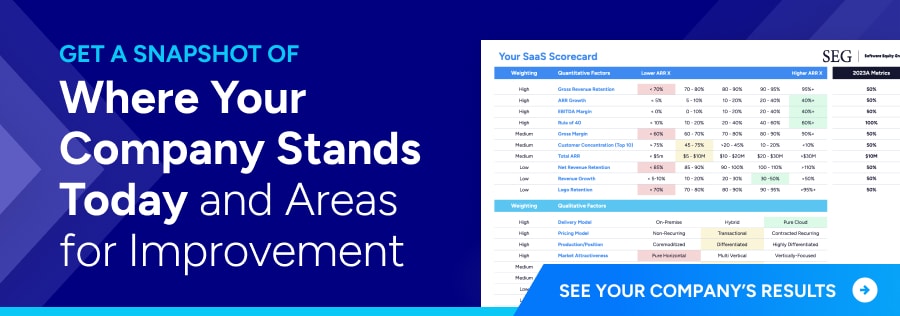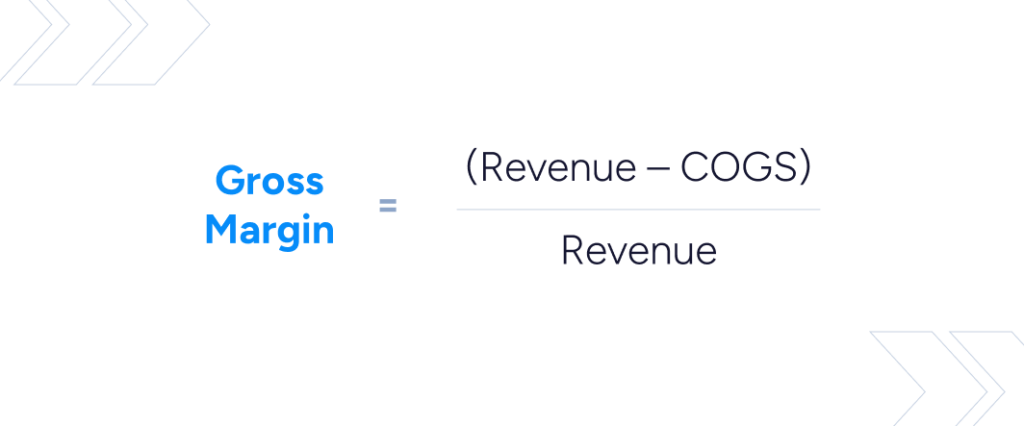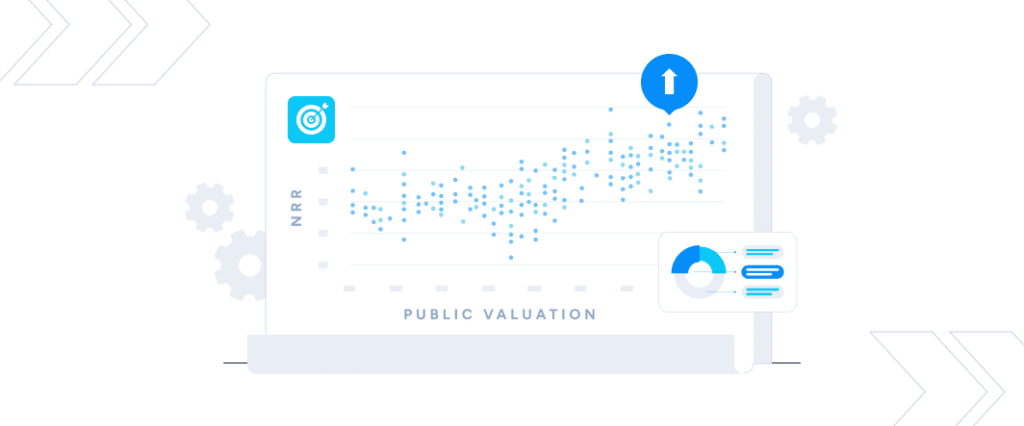How To Calculate Churn Rate Correctly (With Formulas and Examples)
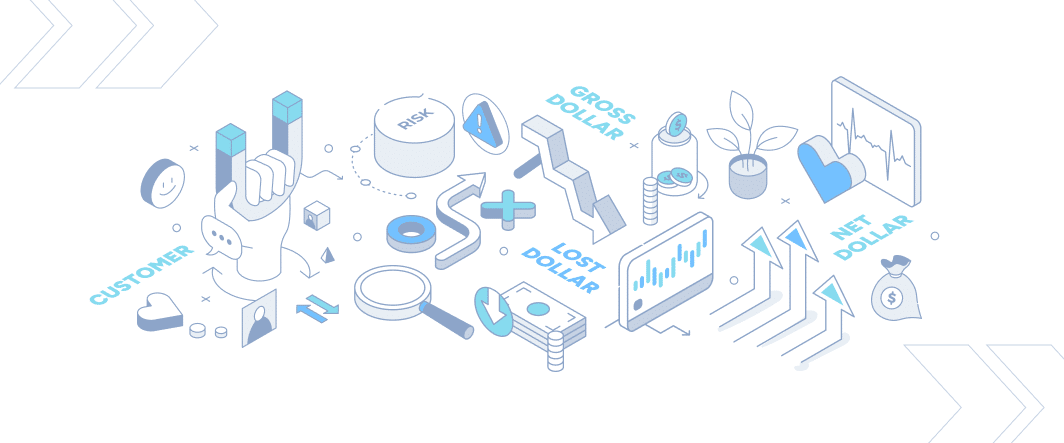
How can you scale sustainably when growth goals are hindered by customer churn? For software executives focused on M&A and growth, managing churn is more than just a KPI; it’s a key to maintaining and amplifying momentum.
What’s more, customer churn puts undue pressure on the sales team to keep winning new customers so the company can maintain growth. By closely tracking churn metrics, you gain insights that can strengthen your retention strategy—ultimately fueling stable, long-term growth.
The software industry uses several types of churn to evaluate businesses, including customer or logo, lost dollar, gross dollar, and net dollar churn. But more on this later. In this article, we’ll explore the essential churn metrics that indicate the health of your customer base and break down how to calculate each one. You’ll learn how to interpret various types of churn and understand what these metrics reveal about your company’s operational efficiency—and its potential appeal to buyers.
- What is Churn in Software Companies?
- Low vs. High Churn Rates and What They Reveal
- How to Use Churn to Your Company’s Benefit
- Breaking Down the 4 Types of Churn Rates (with Calculations)
- 1. Customer Churn
- Example Calculation for Software Companies:
- What is a “Good” Customer Churn Rate?
- 2. Lost Dollar Churn
- Example Calculation for Software Companies:
- What is a “Good” Lost Dollar Churn Rate?
- 3. Gross Dollar Churn
- Example Calculation for Software Companies:
- What is a “Good” Gross Dollar Churn?
- 4. Net Dollar Churn
- Example Calculation for Software Companies:
- What is a “Good” Net Dollar Churn?
- 4 Strategies to Reduce Software Churn Rates
- 1. Automate Churn Reduction
- 2. Engage in Upselling and Cross-Selling
- 3. Establish a Customer Success Team
- 4. Acquire Companies with Complementary Tech
- The Impact of Churn Rates in the M&A Process
- Optimize SaaS Churn Rates to Enhance Exit Opportunities
What is Churn in Software Companies?
As mentioned, understanding and managing different types of churn affects your bottom line and your ability to attract quality investors and buyers. For example, if you’re only looking at one variation of churn, such as logo churn, but ignoring net dollar churn, you could be missing out on important insights.
In the broadest sense of the term, churn is a measurement of the subscribers, clients, accounts, or customers a company loses over a period of time. For software businesses, churn generally refers to when subscriptions are canceled or decreased (in dollars spent). This metric is often expressed as a percentage rate. It can also be indicated by whole numbers, such as a report listing a churn of 250 subscribers or an annual recurring revenue (ARR) churn of $10,000.
Low vs. High Churn Rates and What They Reveal
A low churn rate signals that you’re meeting customer needs and keeping revenue steady or growing, while a high churn rate may indicate customer satisfaction, product quality, or competitive positioning issues.
How to Use Churn to Your Company’s Benefit
Churn rates, which measure customer growth and turnover, offer invaluable insights into your company’s customer base, financial performance, and areas for improvement. By analyzing churn, you can pinpoint where to focus on better supporting existing customers and reducing turnover.

Churn is also a key factor in calculating customer lifetime value (LTV), a critical metric for understanding your business’s unit economics. Without knowing your churn rate, you cannot accurately calculate LTV.
Beyond financial metrics, churn rates help shape effective sales and marketing strategies. They allow sales teams to identify and proactively engage customers at risk of downgrading or unsubscribing, enabling your software company to concentrate resources on boosting customer retention and maximizing ROI on time, effort, and spend.
By incorporating churn metrics into your annual tracking, you can make more informed decisions for both immediate and long-term planning. Buyers, industry peers, and financial professionals also look at your churn rate to gauge business stability.
Breaking Down the 4 Types of Churn Rates (with Calculations)
Since churn is the inverse of your retention or renewal rate, calculating it is straightforward if your renewal rate is known. For example, with a renewal rate of 85%, the churn rate would be 15%. However, calculating churn directly provides a more thorough understanding of the various factors that influence customer retention. Below are formulas to calculate the most common types of churn.
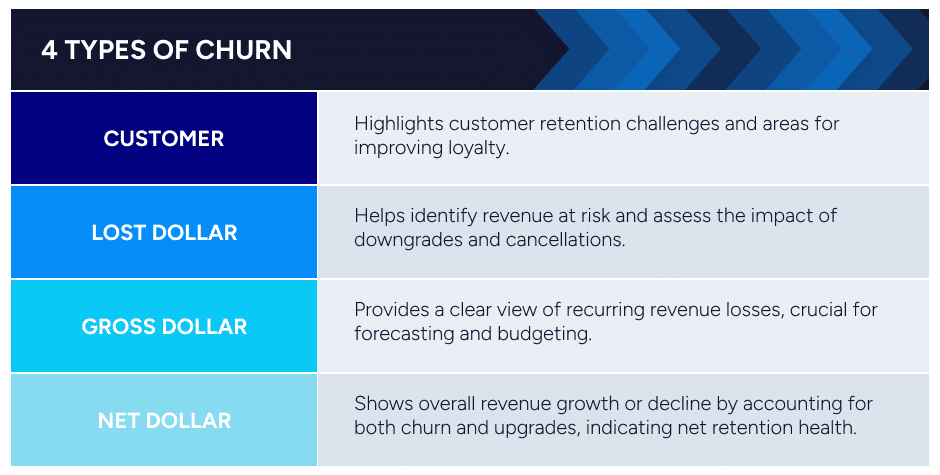
1. Customer Churn
Customer churn, also known as logo churn, measures the number of customers lost over a specific time period. For software businesses, it reflects the percentage or count of subscribers who discontinue their plans. Customer churn can be calculated for any defined period and plays a vital role in determining your customer lifetime value.
Customer churn rate = number of lost customers over a period / customers at the start of the period
Example Calculation for Software Companies:
Suppose your software company began with 5,000 subscribers and ended with 4,500 due to customer cancellations.
In this scenario:
Customer Churn Rate = (5,000 – 4,500) / 5,000
Customer Churn Rate = 500 / 5,000
Customer Churn Rate = 0.10 or 10%
This results in a customer churn rate of 10%, indicating the percentage of subscribers lost during that period.
What is a “Good” Customer Churn Rate?
For a SaaS company, 10% is a good benchmark. A lower logo churn rate is ideal, while higher rates may signal underlying issues. Your customer churn rate is influenced by several factors, including your target market, product pricing and quality, user experience, and customer service. Because these factors can vary widely within an industry, comparing your churn rate to companies of similar size, maturity, and market focus provides more meaningful insights than a broad industry comparison.
2. Lost Dollar Churn
Lost dollar churn measures the dollar amount, or ARR, lost over a specific period. This type of churn provides insight into revenue impact rather than just customer count. To calculate the lost dollar churn rate, divide the total ARR lost during the period by your total ARR at the start of that period. This metric is crucial for understanding the financial effects of customer losses and is commonly used in subscription-based businesses to gauge ARR.
Lost Dollar Churn = ARR lost over a period / total ARR at the start of the period
Example Calculation for Software Companies:
Suppose your software company started with $500,000 in ARR and ended with $475,000 due to customer cancellations or downgrades. To calculate your lost dollar churn rate, use the following formula:
As an example:
Lost Dollar Churn = ($500,000 – $475,000) / $500,000
Lost Dollar Churn = $25,000 / $500,000
Lost Dollar Churn = 0.05 or 5%
This means your annual lost dollar churn rate is 5%, which indicates the percentage of ARR lost from existing customers due to cancellations or downgrades.
What is a “Good” Lost Dollar Churn Rate?
A lost dollar churn of 10% or lower is typically acceptable for SaaS businesses. This benchmark suggests that a company is effectively retaining ARR from its existing customer base, which is essential for stable growth. However, the ideal lost dollar churn rate can vary depending on the company’s maturity, target market, and business model.
3. Gross Dollar Churn
Gross churn measures the revenue lost by your business on an annual basis due to cancellations or downgrades of recurring subscriptions. It encompasses both the lost dollar churn and any contraction in ARR from customers who have downgraded their plans. This combined figure provides a comprehensive view of ARR erosion from existing customers.
Gross Dollar Churn = lost revenue from cancellations + lost revenue from downgrades / ending revenue of period
Example Calculation for Software Companies:
Let’s say your software company began with $500,000 in ARR. Then, you lost $20,000 due to customer cancellations and another $10,000 from downgrades. Gross dollar churn includes both these losses, providing a full view of the revenue contraction.
As a breakdown:
Gross Dollar Churn = ($20,000 + $10,000) / $500,000
Gross Dollar Churn = $30,000 / $500,000
Gross Dollar Churn = 0.06 or 6%
This results in a gross dollar churn rate of 6%, reflecting the total revenue lost from cancellations and downgrades.
What is a “Good” Gross Dollar Churn?
Using gross dollar churn alongside logo churn provides valuable insights into the types of customers who are churning. You might discover that a larger portion of churn comes from lower-priced subscribers rather than higher-value customers, or that downgrades are more common than outright cancellations. This detailed data enables better-informed business decisions.
For SaaS companies, a gross dollar churn rate of 15% or lower is generally recommended, as this metric is widely considered one of the most important indicators of retention health.
4. Net Dollar Churn
The net dollar churn rate reflects changes in recurring revenue resulting from subscription downgrades, upgrades, and cancellations. Many companies use tactics like cross-selling or upselling to existing customers to help offset losses from customer cancellations or downgrades.
This metric captures the ARR churn from existing customers, factoring in both revenue lost to cancellations and downgrades and revenue gained from customer upgrades. Net churn can be measured on an annual basis. To calculate your net dollar churn, use the following formula:
Net Dollar Churn = lost revenue from cancellations + lost revenue from customer downgrades or spending less – revenue gains from existing customers spending more
Example Calculation for Software Companies:
Imagine your software company lost $5,000 in revenue from customer cancellations and an additional $2,000 from downgrades. However, you gained $10,000 from increased customer spending through upgrades.
In this example:
Net Dollar Churn = $5,000 + $2,000 – $10,000
Net Dollar Churn = –$3,000
This results in a negative net dollar churn of $3,000, which is a positive growth indicator for SaaS companies. Achieving negative net churn means your company is growing its revenue from existing customers, reducing dependency on acquiring new customers for growth.
Related Reading: How Net Retention Impacts Public Software Company Valuations & What Private Companies Can Learn
What is a “Good” Net Dollar Churn?
A “good” net dollar churn rate is ideally negative, meaning that revenue growth from existing customers (through upgrades or expanded usage) outweighs losses from downgrades and cancellations. Achieving negative net churn indicates that your company can grow recurring revenue without relying solely on new customer acquisition, a strong indicator of product value and customer satisfaction.
For most SaaS businesses, aiming for net dollar churn at 0% or lower is considered healthy, while significantly negative net churn rates signal robust customer expansion and revenue retention.
4 Strategies to Reduce Software Churn Rates
If your company’s churn metrics exceed the recommended levels mentioned above, it’s essential to take steps to reduce them. Here are some actionable strategies to enhance customer satisfaction and increase their engagement with your business:
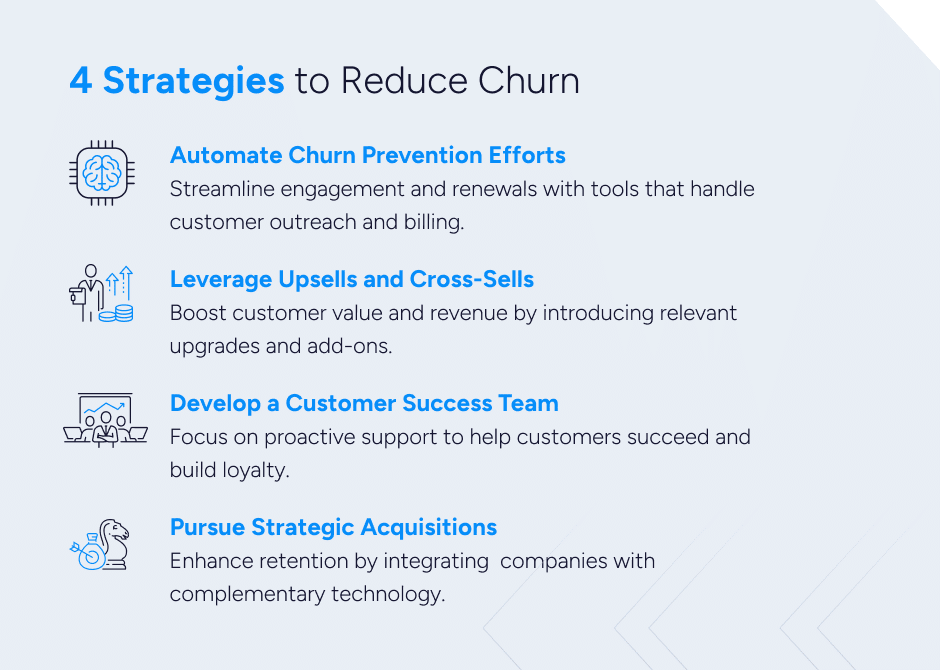
1. Automate Churn Reduction
Take advantage of software tools that can help reduce churn automatically, freeing up your team’s time and resources. Most CRM software, for instance, can automate personalized customer outreach, allowing for consistent engagement without manual effort.
Additionally, specialized applications for SaaS companies streamline subscription and revenue management tasks. Tools like NetSuite, Maxio, ChargeBee, and Recurly can help manage renewals, billing, and customer data, all of which aim to reduce churn and improve customer retention.
2. Engage in Upselling and Cross-Selling
An effective way to improve churn metrics is to focus on selling upgrades and additional services to existing customers. Research indicates that increasing the “share of wallet” with current customers is often more cost-effective than acquiring new customers unfamiliar with your company. By introducing customers to the benefits of new features or higher-tier plans tailored to their needs, you enhance the value they receive while generating additional annual recurring revenue.
3. Establish a Customer Success Team
Unlike a traditional support team that functions as a “help desk,” a customer success team takes a proactive approach, working directly with customers to ensure they achieve their business goals using your product. This includes comprehensive onboarding and training, ongoing account management to identify and address potential issues, and actively gathering customer feedback to enhance the customer experience continually. A customer success team helps your organization anticipate customer needs and fosters stronger, lasting relationships.
4. Acquire Companies with Complementary Tech
If your software integrates well with another company’s technology, acquiring that company could be a strategic way to reduce churn for both businesses. By adding complementary features to your product suite, you can better meet customer needs and create a more “sticky” relationship, increasing the likelihood of long-term retention. An acquisition also provides an opportunity to merge customer success teams, enabling faster and more comprehensive support for a seamless customer experience.
The Impact of Churn Rates in the M&A Process
While understanding churn is critical to building a successful business, it also has a significant impact on your exit opportunities. If you are considering selling your company, prospective buyers will closely examine your churn rate to assess customer loyalty, forecast future revenue, and evaluate long-term growth potential.
Companies with low churn rates typically attract higher valuations in the M&A process, as they provide acquirers with greater confidence in a stable, recurring revenue stream. Conversely, a high churn rate may lead buyers to lower their valuation to account for perceived risks of instability.
During due diligence, buyers will scrutinize the churn rate from multiple perspectives. If their findings raise concerns, it could jeopardize a deal in progress. Therefore, working to improve your churn rates now is a strategic move to facilitate any future M&A deals.
Read More: Can You Sell Your SaaS Company on Your Own? Tips from a Founder
Optimize SaaS Churn Rates to Enhance Exit Opportunities
Consistently low churn rates signal strong customer retention and stable recurring revenue, making your company more attractive to buyers. This reliability not only boosts valuation but also fosters confidence, leading to a smoother, more efficient transaction process.
Effectively controlling churn can drive sustainable growth and help secure a premium valuation at exit. Note: While some level of churn is unavoidable, knowing which metrics to calculate and analyze is the first step to improving your rates across the board.
Discover how your churn rates impact your company’s valuation potential with our Interactive SEG SaaS Scorecard™. This powerful tool not only provides insights into your valuation but also highlights where your company excels or lags based on today’s market standards, helping you pinpoint key areas for growth and improvement.




